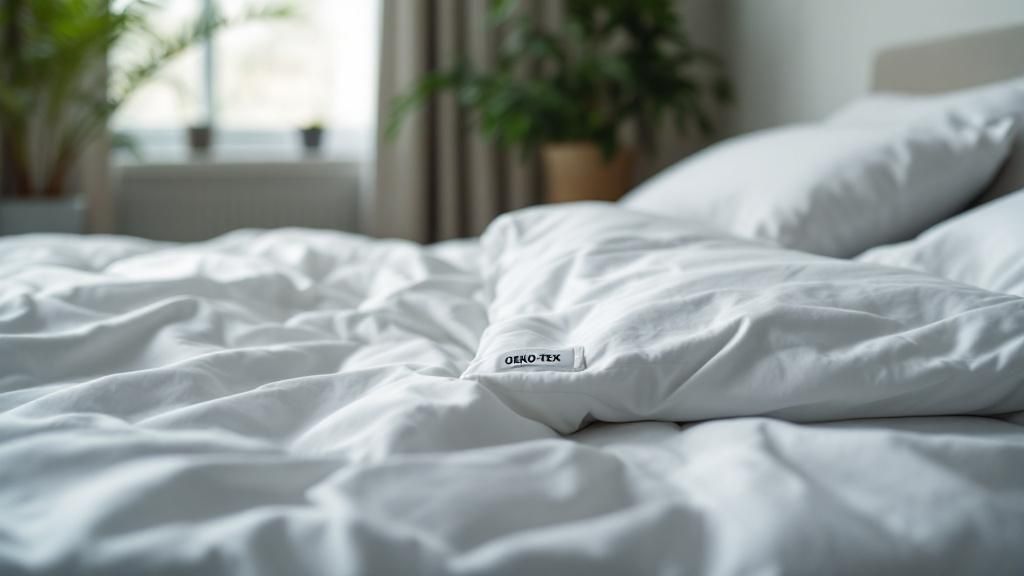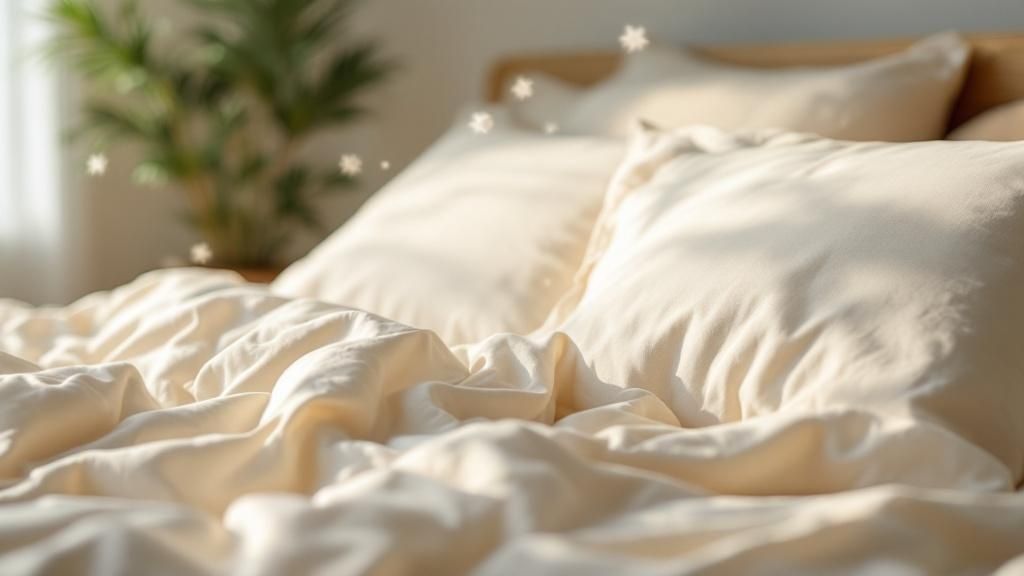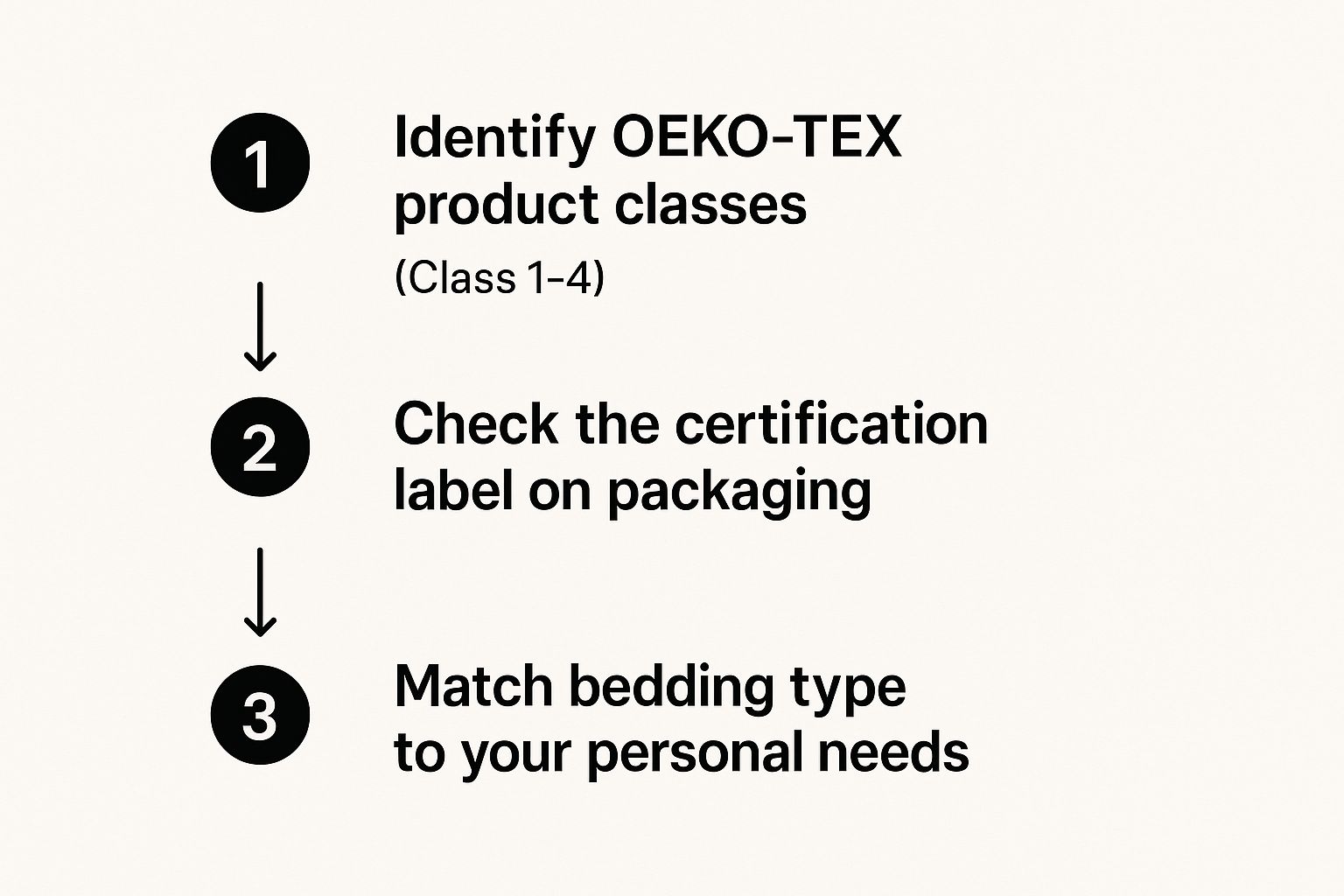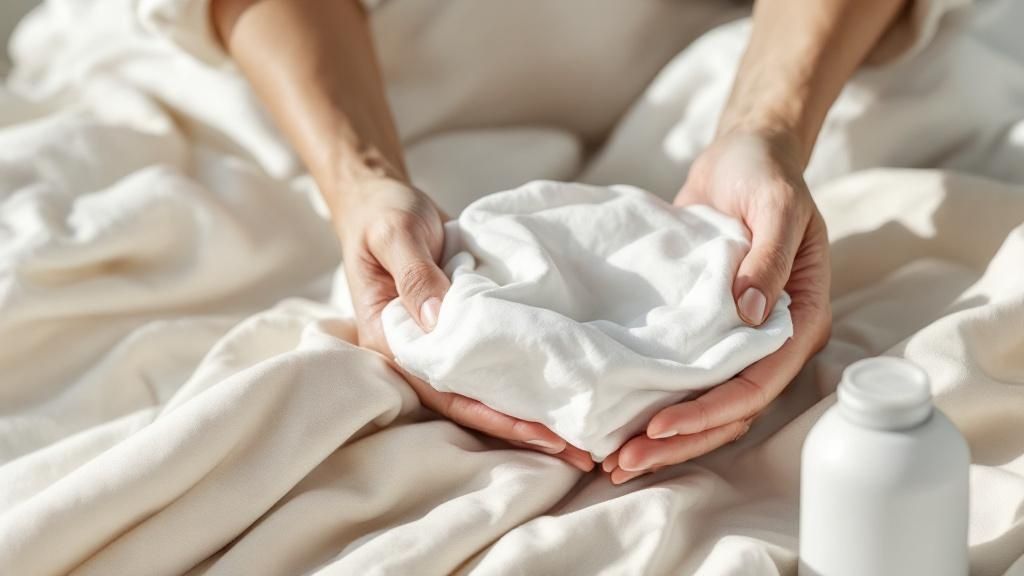When you see a label on bedding that says "OEKO-TEX certified," what does that actually mean for you? In short, it means every single component of that product—right down to the thread, buttons, and zippers—has been rigorously tested and cleared of more than 100 harmful substances. It's a direct promise of product safety, assuring you that what you're sleeping on is free from chemicals that could be detrimental to your health.
What OEKO-TEX Certified Bedding Really Means

Let's cut through the jargon. The STANDARD 100 by OEKO-TEX label is more than just another green buzzword. It's a globally respected, independent certification focused squarely on human health and safety.
Think of it as a clear signal that the bedding you wrap yourself in every night is safe from problematic chemicals. This includes things like residual pesticides, carcinogenic dyes, and heavy metals that have no business being near your skin.
This kind of meticulous testing is especially critical for items we're in close contact with for hours at a time. If you have sensitive skin, allergies, or are a parent choosing bedding for your children, seeing that OEKO-TEX label provides some much-needed peace of mind.
OEKO-TEX Versus Organic
It's easy to get these two mixed up, but it's important to know that OEKO-TEX certified and organic aren't the same thing. They both represent positive qualities in a product, but they focus on completely different aspects of its lifecycle.
To clear things up, here’s a quick comparison:
OEKO-TEX vs Organic: A Quick Comparison
| Focus Area | OEKO-TEX STANDARD 100 | Organic (GOTS) |
|---|---|---|
| Primary Goal | Human-health safety of the final product. | Environmental impact and natural origin of the raw fibers. |
| What's Tested? | The finished item and all its components (fabric, thread, dyes, etc.). | The farming and harvesting process of the fibers (e.g., cotton, linen). |
| Key Guarantee | Free from a specific list of harmful chemicals. | Grown without synthetic pesticides, herbicides, or GMOs. |
Essentially, an organic certification like GOTS (Global Organic Textile Standard) tells you about the origin of the fibers. OEKO-TEX, on the other hand, is all about the safety of the final product you bring home.
A product can be made from 100% organic cotton but still be processed with harsh dyes or chemical finishes during manufacturing. This is where OEKO-TEX steps in. While having both labels is the gold standard, the OEKO-TEX certification is the ultimate indicator of direct-to-skin safety.
This growing awareness among shoppers is making a real impact. The home textiles market is currently valued at USD 185.97 billion and is expected to climb as more of us prioritize health in our purchasing decisions.
Choosing OEKO-TEX certified bedding, like premium bamboo viscose sheets, is a practical step toward building a healthier sleep environment. You can explore the benefits of bamboo fabric in our detailed guide to learn more about how material choice affects your nightly comfort. This label empowers you to look past vague marketing claims and choose products that have been verified as safe.
Decoding the Different OEKO-TEX Labels You'll See

When you first start looking for OEKO-TEX certified bedding, you'll quickly notice there isn't just one single label. It can be a little confusing, but understanding the differences is crucial for finding bedding that truly aligns with your values—whether your main concern is health, environmental impact, or a bit of both.
The label you’ll bump into most often is STANDARD 100 by OEKO-TEX. Think of this as the gold standard for product safety. When you see this label, it means every single component of the item, from the thread and buttons to the zippers and dyes, has been rigorously tested for a long list of substances that could be harmful to your health.
Beyond Just Product Safety
For shoppers who want to dig a little deeper into how their bedding was made, the MADE IN GREEN by OEKO-TEX label is the one to look for. This certification goes a step further. It includes all the human-safety guarantees of STANDARD 100, but it also verifies that the item was produced in environmentally friendly facilities where workers are treated fairly.
So, what's the real difference for you?
- STANDARD 100: This is all about your health. It answers one critical question: "Is this bedding free from harmful chemicals and safe for my family?"
- MADE IN GREEN: This covers health, the environment, and ethics. It tells you the product is safe and that its journey from raw material to your bedroom was a responsible one.
Ultimately, the right label depends on your priorities. If your top goal is to ensure your sheets are non-toxic and won't irritate your skin, STANDARD 100 is an excellent and reliable benchmark. If you also care deeply about sustainable manufacturing and ethical treatment of workers, then MADE IN GREEN provides that extra peace of mind.
This growing desire for safer, more transparent products is making a real impact. The market for items like organic and OEKO-TEX certified bedding is projected to jump from USD 838 million in 2024 to more than USD 1.3 billion by 2035. You can discover more about this growth in the organic bedding market and see just how much our choices as consumers are driving change in the industry.
How to Confidently Verify Any OEKO-TEX Label
With so many vague claims floating around, it's smart to be a little skeptical. But here’s the good news: you don't have to just take a brand's word for it. You can personally confirm any legitimate claim for OEKO-TEX certified bedding in under a minute using their official verification tool.
First things first, find the physical tag on the product itself. You’re looking for a unique label number—it’s a required part of the certification and your key to unlocking the truth. Once you have that number, the rest is easy.
This is what you'll see on the official OEKO-TEX Label Check website. It’s a simple, powerful tool designed for people like us.

Just type the number from the product's tag into that search field, and you'll immediately see if the certification is valid.
What a Valid Certificate Actually Tells You
When you verify a label, the website doesn't just give you a thumbs-up. It shows you the official certificate with a wealth of information. This is where you can really dig in.
Here’s what you’ll find:
- The Certified Company: This confirms which brand or manufacturer actually holds the certificate.
- The Expiration Date: OEKO-TEX certifications are only valid for one year. This ensures companies are re-testing their products to maintain compliance.
- The Specific Articles Covered: The certificate will list exactly what it applies to, like "bed-linen made of 100% cotton" or "terry towels."
- The Product Class: This is crucial. It specifies the level of testing, from the strictest Product Class 1 (for babies) to Product Class 4 (for decorative materials).
A valid certificate is your direct proof that the product you're holding has passed the test. If you enter a number and it comes back invalid, or it’s for a completely different product, you've likely spotted a fake claim. This simple check puts the power back in your hands.
This whole process is about making sure the bedding you bring into your home has the right level of certified safety for your family. It’s a quick step that provides genuine peace of mind.
The Real-World Benefits of Certified Bedding
When you see a certification on a bedding label, it’s more than just a technical detail. It represents real, tangible benefits for you, your family, and the planet. Choosing oeko tex certified bedding is a conscious decision that genuinely impacts your health and supports a more sustainable world.
Think about it—we spend about a third of our lives with our skin pressed against our sheets. The biggest personal advantage is knowing you're not sharing your bed with chemical irritants. Certified bedding guarantees that every single component, from the fabric itself to the threads and dyes, has been rigorously tested and found free from harmful substances like formaldehyde, heavy metals, and residual pesticides.
This is a game-changer for anyone with sensitive skin or allergies, and it’s especially important for children, whose bodies are more vulnerable. Creating a sleep sanctuary free from known irritants can lead to more comfortable nights and better overall well-being.
A Healthier Planet and Healthier People
The positive impact doesn't stop at your bedroom door. Certifications like MADE IN GREEN are a powerful force for good, pushing manufacturers to adopt more responsible production methods. This means holding factories accountable for cleaner water discharge and ensuring their workers have safe, ethical conditions.
Choosing certified bedding is an investment in both personal wellness and global responsibility. It’s a vote for transparency, safety, and a manufacturing process that respects both people and the planet.
This movement toward safer textiles is gaining serious traction. In 2023, Europe became the second-largest market for organic bedding, with sales reaching approximately 11.3 million units. Many of these products proudly carry an OEKO-TEX label as a mark of safety. This consumer trend is bolstered by regional policies promoting low-emission textiles, signaling a clear market shift. You can discover more insights about the European organic bedding market and its continued growth.
Ultimately, opting for certified materials is a simple action with a powerful ripple effect. If you're curious about how specific materials can enhance your sleep, particularly for hot sleepers, check out our guide on why bamboo sheets are a cool and eco-friendly choice.
Practical Shopping Tips for Finding Your Perfect Bedding
So, you're ready to find your new bedding. It can feel like a maze out there, but I've got a few strategies that will make your search for oeko tex certified bedding a whole lot simpler. Creating a safer sleep environment is easier than you think.
First, let's broaden the scope beyond just the sheets. The OEKO-TEX certification isn't limited to what you sleep between—it can apply to every single textile in your bedroom. I'm talking about the things we often forget, like mattress protectors, the pillows themselves, and even that decorative throw blanket at the foot of the bed. Certifying everything is the real secret to building a complete sleep sanctuary.
Shopping Smart Online and In-Store
When you're shopping online, treat the product description like your treasure map. Hunt for the official OEKO-TEX label image and a clear mention of the certification. If you don't spot it right away, use the site's search bar. Typing in "OEKO-TEX" or "certified" is a quick way to filter out everything else.
If you prefer to shop in a brick-and-mortar store, you've got the advantage of having the product right in your hands. Flip over the packaging and look for that official STANDARD 100 label. Don't ever hesitate to flag down a sales associate to point you in the right direction if you're having trouble. It's what they're there for.
Pro Tip: I see this all the time—people assume "certified" means "expensive." That's just not the case anymore. Many affordable, everyday brands have embraced OEKO-TEX certification. Decide on your budget first; I'm willing to bet you'll find fantastic options that tick both your financial and wellness boxes.
Beyond the Label: What to Consider
Once you've confirmed a product is certified, the next step is choosing the right fabric for you. Cotton and linen are timeless, but don't overlook other great materials. For instance, bamboo viscose is famous for its incredible softness and ability to regulate temperature, which is a game-changer for hot sleepers or anyone with sensitive skin. If that sounds like you, check out this complete guide to choosing perfect bamboo sheet sets.
To nail down your final choice, ask yourself these questions:
- What kind of feel do I want? A sateen weave gives you that silky, lustrous finish, while percale is known for being crisp, light, and cool.
- Who is this for? If you're buying for an infant or toddler, you'll want to look specifically for Product Class 1, as it meets the most stringent safety standards.
- Is it easy to care for? Always check the care instructions. The most comfortable sheets in the world aren't worth it if they have high-maintenance washing requirements that don't fit your life.
By pairing smart label-checking with these practical questions, you can confidently bring home bedding that's not just safe and free from harmful substances, but also perfectly matched to your personal comfort.
Answering Your Top OEKO-TEX Questions

Even with all the benefits laid out, I find people still have a few key questions when it comes to choosing OEKO-TEX certified bedding. It's completely understandable. Let's walk through some of the common points of confusion so you can feel 100% confident you're creating the healthiest sleep environment possible.
A question I get asked a lot is, "Can't I just wash new, uncertified sheets to get rid of the chemicals?" While washing can definitely help remove some surface residues, it's not a foolproof solution. Many chemicals, like certain dyes or heavy metals, are bonded right into the fabric fibers and won't wash out. Certification gives you peace of mind that the fabric was safe from the get-go.
Another common mix-up is the difference between "OEKO-TEX certified" and "hypoallergenic." They sound similar, but there's a crucial distinction. Bedding that's been certified has been tested against a long list of known skin irritants, which naturally makes it a fantastic choice for anyone with sensitive skin.
Here's the key takeaway: OEKO-TEX provides a specific, verifiable standard for chemical safety. "Hypoallergenic," on the other hand, is an unregulated marketing term that brands can use quite freely. If you want a real guarantee against chemical irritants, the OEKO-TEX label is the one to look for.
Organic vs. Certified: A Final Clarification
So, if you see bedding made from organic cotton, does that mean it's also OEKO-TEX certified? Not necessarily. These are two separate certifications that cover different things. A fabric can be grown organically, meeting all the agricultural standards, but then be treated with harsh chemical dyes or wrinkle-resistant finishes in the factory.
For the absolute gold standard in healthy and sustainable bedding, you want to see both a GOTS (organic) label and an OEKO-TEX label. This powerhouse combination tells you the fibers were grown naturally and the final product you're sleeping on is free from harmful substances. For instance, materials like 100% bamboo viscose can be both organically sourced and OEKO-TEX certified, giving you the best of both worlds.
Ready to feel the difference for yourself? Bamtek offers premium bedding crafted from 100% organic bamboo viscose, certified by both OEKO-TEX Standard 100 and Organic 100 for your complete peace of mind. Discover our collection of soft, breathable, and certified-safe bedding today at bamtekhome.com.










